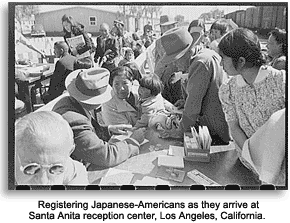The surprise attack and bombing of Pearl Harbor by Japan in 1941, set into motion far-reaching measures to prevent the reoccurrence of such treachery. Impelled by military necessity, and for the security of the Pacific West Coast, people of Japanese descent in the tens of thousands were forcibly relocated from the region.
As the United States entered World War II, there were approximately 5,000 Japanese Americans in the U.S. armed forces. They were immediately classified as 4-C, or enemy aliens — despite their U.S. citizenship. Based on secret army intelligence reports indicating an "espionage network containing Japanese aliens, first- and second- generation Japanese working together underground..." a military decision was made to summarily discharge many of those 5,000 servicemen. Those who remained played a vital role in the war as the 100th Battalion/442nd Regimental Combat Team, winning numerous citations for conspicuous bravery.
Considering it to be of utmost importance to the national security, the government began the registration of enemy aliens on February 2, 1942. At the same time, the FBI began secret, random search-and-seizure raids at the homes and businesses of Japanese residents, rounding up dangerous members of the Japanese Black Dragon Society. The Secretary of War met with President Franklin D. Roosevelt to ask for authorization to remove alien and citizen Japanese to detention camps. General John L. DeWitt, commander of the Fourth Army headquarters at the Presidio of San Francisco, expressed his concern about an "expected violent outburst of coordinated and controlled sabotage" among the Japanese population.
A Civil Control Station was set up, to which a responsible member from each Japanese family was to report for registration and further instructions. Fearing more Japanese attacks on their cities, homes, and businesses, government leaders in California, Oregon, and Washington, insisted that the Japanese residents be removed and placed in isolation farther inland. Facing the uncertainty of war and mounting pressure from the people, President Roosevelt signed Executive Order 9066 on February 19, 1942, which resulted in the forcible internment of people of Japanese ancestry.
The military moved in on what they thought to be the enemy in a timely and dignified manner. With time of the essence, the Justice Department announced that strategic locations must be cleared of any such aliens by February 24th.
It was without serious incident that one of the largest migrations in history took place in early spring of 1942. Under military supervision, the U.S. Government evacuated more than 110,000 people of Japanese descent and placed them into 10 wartime enclaves. More than two thirds of those interned under the executive order were U.S. citizens, and none had ever demonstrated any disloyalty.
Forced to carry on their lives under harsh weather conditions and unfamiliar surroundings, the exiles took up residence in the internment camps. Leaving behind their homes and businesses, they were scattered all over the interior West in isolated desert areas.
We only did that to the Japanese. We never did that to Germans and Italians.


No comments:
Post a Comment